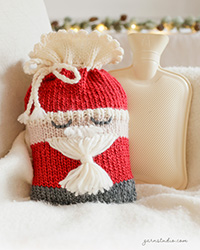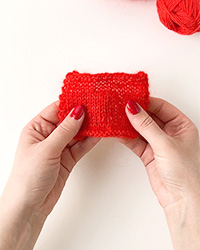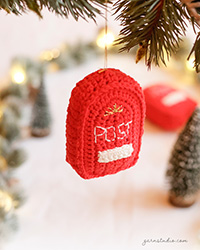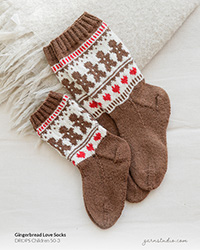How to work German Short Rows – with a double stitch back and forth on the needle
When working short rows, there will be a small hole - this can be closed by tightening the thread or using the German short row technique.
Row 1 (= right side):
Knit until where the piece is to be turned, turn, when it is knitted further there will be a small hole at the turn - this hole can be closed like this:
Row 2 (= wrong side):
Slip the 1st stitch from the left needle as if to purl, have the thread at the front towards you, place the thread over the right needle and tighten the thread well before purling the next stitch = the first stitch on the right needle has now become a double stitch (with a stitch and a thread). Purl until where the work is to be turned. Turn the work.
Row 3 (= right side):
Slip the 1st stitch from the left needle as if to purl, have the thread at the front towards you, place the thread over the right needle and tighten the thread well before knitting the next stitch = the first stitch on the right needle has now become a double stitch.
Knit until the double stitch from the previous row and knit the double stitch so that the thread that was placed over the needle and the stitch is knitted together = 1 stitch. Knit until where the work is to be turned. Turn the work.
Row 4 (= wrong side):
Slip the 1st stitch from the left needle as if to purl, have the thread at the front towards you, place the thread over the right needle and tighten the thread well before purling the next stitch = the first stitch on the right needle has now become a double stitch. Purl until the double stitch from the previous row and purl the double stitch so that the thread that was placed over the needle and the stitch is purled together = 1 stitch. Purl until where the work is to be turned. Turn the work.
Repeat 3rd and 4th row.
We use the yarn DROPS Snow in the video. This technique is used in several patterns - you can find patterns by clicking on the pictures below:
Patterns using this technique
Video #1794, listed in: Learn to knit, Knitting tips & tricks, Short Rows, German Short Rows
Our videos do not have sound. We are a worldwide company and our videos are watched by people speaking endless of different languages and many do not understand English. So since there is not a given language for us to use, we instead have written instructions to accompany the video, and then there is no sound to disturb while watching.
You can adjust the speed of this video by clicking on the icon, on the play bar.
![]() Jytte Mikkelsen wrote:
Jytte Mikkelsen wrote:
Er i gang med 263-38, cardigan. Ved halsudskæring 1. pind, vrangsiden, skal jeg lave forkortet pind og vende arbejdet; det betyder, at jeg strikker ret tilbage på resten af pinden. Herefter skal jeg så i gang med en vrangpind igen som 2. pind. Men ifl. opskriften skal 2. pind være ret? Hvor langt skal jeg strikke efter at have vendt? Vh. jytte Vh. Jytte
17.09.2025 - 20:58
![]() Margareta Andersson wrote:
Margareta Andersson wrote:
Stickar väst nr 255-9. Vid användning av förkortade varv på axel har jag 24 m och ska sticka 22 m och sedan vända och göra german shorts row och fortsätta sticka varvet ut På nästa varv ska jag vända efter 20 stickade maskor osv men maskorna som är längst ut på varvet blir ju aldrig stickade. Är det något som jag gör fel eller tänker jag fel? Tacksam för svar
21.05.2025 - 18:35DROPS Design :
Hei Margareta. Når du har strikket ferdig både høyre og venstre skulder (med forkortede pinner), legges det opp nye masker og skulderstykkene er nå sammen igjen, og da strikkes det over alle maskene igjen (og du er nå på bakstykket). mvh DROPS Design
26.05.2025 - 07:53
![]() Ana wrote:
Ana wrote:
¿Es una traducción de algún traductor? Está escrito fatal.
12.01.2025 - 20:33Leave a comment or question to this video
Your email address will not be published. Required fields are marked *.























Ahhh !! Merciiii !!! Vous êtes une mine !!!!
17.11.2025 - 19:30